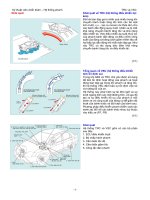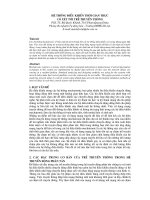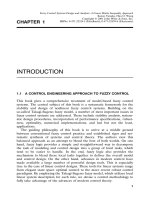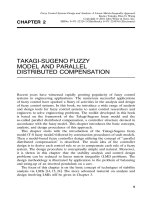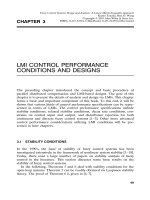Tài liệu Hệ thống điều khiển mờ - Thiết kế và phân tích P13 pptx
Bạn đang xem bản rút gọn của tài liệu. Xem và tải ngay bản đầy đủ của tài liệu tại đây (161.27 KB, 17 trang )
Fuzzy Control Systems Design and Analysis: A Linear Matrix Inequality Approach
Kazuo Tanaka, Hua O. Wang
Copyright ᮊ 2001 John Wiley & Sons, Inc.
Ž. Ž .
ISBNs: 0-471-32324-1 Hardback ; 0-471-22459-6 Electronic
CHAPTER 13
MULTIOBJECTIVE CONTROL
VIA DYNAMIC PARALLEL
DISTRIBUTED COMPENSATION
wx
This chapter treats the multiobjective control synthesis problems 1᎐5 via the
Ž.
dynamic parallel distributed compensation DPDC . It is often the case in the
practice of control engineering that a number of design objectives have to be
achieved concurrently. The associated synthesis problems are formulated as
Ž.
linear matrix inequality LMI problems, that is, the parameters of the DPDC
controllers are obtained from a set of LMI conditions. The approach in this
chapter can also be applied to hybrid or switching systems.
We present the performance-oriented controller synthesis of DPDCs to
incorporate a number of practical design objectives such as disturbance
attenuation, passivity, and output constraint. Performance specifications
presented in this chapter include L gain, general quadratic constraints,
2
generalized H performance, and output and input constraints. The con-
2
troller synthesis procedures are formulated as LMI problems. In the case
of meeting multiple design objectives, we only need to group these LMI
conditions together and find a feasible solution to the augmented LMI
wx
problem 15 .
q
w .
p
Ž
q
.
First we introduce some notation: ᑬ s 0, ϱ ; L ᑬ is defined as the
2
Ž.
q
set of all p-dimensional vector valued functions ut, t g ᑬ , such that
55 Ž
ϱ
5 Ž.5
2
.
1r2 e
Ž
q
.
u s H ut dt - ϱ and L ᑬ is its extended space, which is
2
02
Ž.
q
defined as the set of the vector-valued functions ut, t g ᑬ , such that
55
e
Ž
T
5 Ž.5
2
.
1r2 q
u s H ut dt - ϱ for all T g ᑬ .
2
0
As discussed in Chapter 12, in general, the choice of a particular DPDC
parameterization will be influenced by the structure of the T-S subsystems.
In this chapter, we will only discuss DPDC in the quadratic parameteri-
zation form. It is easy to extend the results in this chapter to the cubic
259
MULTIOBJECTIVE CONTROL VIA DYNAMIC PARALLEL DISTRIBUTED COMPENSATION
260
parameterization case. Recall the quadratic parameterization is represented
as
rr r
ij i
x s hphpAxq hBy,13.1
Ž. Ž. Ž .
˙
ÝÝ Ý
cijccic
i
s1 js1 is1
r
i
u s hpCxq Dy,13.2
Ž. Ž .
Ý
iccc
i
s1
or equivalently that
rr r
ij i
Aps hphpA, Bps hpB,
Ž. Ž. Ž. Ž. Ž.
ÝÝ Ý
cijccic
i
s1 js1 is1
13.3
Ž.
r
i
Cps hpC, Dps D .
Ž. Ž. Ž.
Ý
ciccc
i
s1
As in Chapter 12, we use p as premise variables and z as performance
variables.
13.1 PERFORMANCE-ORIENTED CONTROLLER SYNTHESIS
This section presents LMI conditions which can be used to design DPDC
controllers which satisfy a variety of useful performance criteria. The presen-
tation is divided into two subsections. In the first subsection, we assume only
a linear parameter-dependent controller structure and derive a collection of
parameter-dependent conditions expressed in inequalities. Each condition
corresponds to a different performance criterion. In the second subsection,
we restrict our consideration to a DPDC controller structure. This restriction
allows us to convert the parameter-dependent inequalities to parameter-free
LMIs which can be solved numerically
13.1.1 Starting from Design Specifications
We will consider the class of systems G which can be described by the
equations
xts Apxtq Bpwt,
Ž. Ž . Ž. Ž . Ž.
˙
cl cl cl cl
13.4
Ž.
zt s Cpxtq Dpwt,
Ž. Ž . Ž. Ž . Ž.
cl cl cl
Ž. Ž. Ž.
where xt, wt, and zt stand for state, input, and performance variables
Ž.
correspondingly; pt is the system parameter which may be affected by both
the system states or some exogenous input variables.
PERFORMANCE-ORIENTED CONTROLLED SYNTHESIS
261
L Gain Performance
2
wx Ž.
Definition 2 14 : For a casual NLTI nonlinear time-invariant operator G:
e
Ž
q
.
e
Ž
q
.Ž. Ž.
w g L ᑬ ™ z g L ᑬ with G 0 s 0, G is L stable if w g L ᑬ
22 2 2
Ž.
implies z g L ᑬ . Here, G is said to have L gain less than or equal to
22
␥
G 0 if and only if
TT
22
2
zt dtF
␥
wt dt 13.5
Ž. Ž. Ž .
HH
00
for all T g ᑬ
q
.
wx
The well-known Bounded Real Lemma is given below 25 .
ŽŽ. Ž. Ž. Ž..
LEMMA 1 For system G: Ap, Bp, Cp, Dp, the L gain will
cl cl cl cl 2
be less than
␥
) 0 if there exists a matrix P s P
T
) 0 such that
T
L
L
Ap, PPBpCp
Ž. Ž. Ž.
Ž.
cl cl cl
TT
- 0. 13.6
Ž.
BpP y
␥
IDp
Ž. Ž.
cl cl
Cp Dp y
␥
I
Ž. Ž.
cl cl
General Quadratic Constraint
wx Ž.
Definition 3 15 : For a casual NLTI, G: w ™ z with G 0 s 0. Given fixed
y1 TT
Ž.
matrices U s S⌺ S , V s V , and W, where ⌺ ) 0. The variables zt and
Ž.
wt need to satisfy the following constraint:
X
zt U W zt
Ž. Ž.
T
dt - 0, ᭙T G 0, 13.7
Ž.
H
T
ž/ž /ž/
wt W V wt
Ž. Ž.
0
Ž. Ž. Ž
q
.
for x 0 s 0 and wt g L ᑬ .
cl 2
wx Ž
Remark 41 15 : Many performance specifications such as L gain, passiv-
2
.
ity, and sector constraint can be incorporated into this general quadratic
constraint framework by choosing different U, V, and W.
Ž.
X
T
Define the function Vx s xPx, where P s P ) 0. Suppose
cl cl cl
L
L
Ap, PPBpq C
T
W
Ž. Ž.
Ž.
cl cl cl
TTTT
ž/
BpPq WC DWq WDq V
Ž.
cl cl cl cl
T
T
Cp
Ž.
cl
q UC p D p - 0. 13.8
Ž. Ž. Ž .
Ž.
cl cl
T
ž/
Dp
Ž.
cl
MULTIOBJECTIVE CONTROL VIA DYNAMIC PARALLEL DISTRIBUTED COMPENSATION
262
Then
X
d
xt
L
L
Ap, PPBp xt
Ž. Ž . Ž . Ž.
Ž.
cl cl cl cl
Vx t s
Ž.
Ž.
cl
T
ž/ž /ž/
dt
wt B pP 0 wt
Ž. Ž . Ž.
cl
X
zt U W zt
Ž. Ž.
- y .13.9
Ž.
T
ž/ž /ž/
wt W V wt
Ž. Ž.
Ž. Ž.
Inequality 13.7 will result by integrating both sides of 13.9 .
Ž.
Applying the Schur complement to 13.8 , we get the following lemma:
ŽŽ. Ž. Ž. Ž..
LEMMA 2 For system G: Ap, Bp, Cp, Dp, the general
cl cl cl cl
Ž.
T
quadratic constraint 13.7 will be satisfied if there exists a matrix P s P ) 0
such that
TT
L
L
Ap, PPBpq CpWCpS
Ž. Ž. Ž. Ž.
Ž.
cl cl cl cl
TTTT T
BpPq WC WDq DWq VDpS
- 0. 13.10
Ž. Ž.
Ž.
cl cl cl cl cl
TT
SC p SD p y⌺
Ž. Ž.
cl cl
Generalized H Performance
2
wx Ž.
Definition 4 15 : A causal NLTI G: w ™ z with G 0 s 0 is said to have
generalized H performance less than or equal to
if and only if
2
zT F
, ᭙T G 0, 13.11
Ž. Ž .
Ž.
T
5 Ž.5
2
where x 0 s 0 and H wt dtF 1.
cl 0
ŽŽ..
X
Define the function Vx t s xPx, where P ) 0. Suppose
cl cl cl
L
L
Ap, PPBp
Ž. Ž.
Ž.
cl cl
- 0. 13.12
Ž.
T
ž/
BpP y
I
Ž.
cl
Ž.ŽŽ..
X
Ž. Ž. Ž .
Then drdt V x t -
wtwt. We will suppose Dps 0. In this
cl cl
case, if the equation
PC
T
p
Ž.
cl
) 0 13.13
Ž.
ž/
Cp
I
Ž.
cl
X
Ž. Ž. Ž Ž..
is satisfied, then ztzt-
Vx t . This leads to the following lemma:
cl
PERFORMANCE-ORIENTED CONTROLLED SYNTHESIS
263
ŽŽ. Ž. Ž..
LEMMA 3 For system G: Ap, Bp, Cp,0, the generalized H per-
cl cl cl 2
T
Ž.
formance will be less than
if there exists a matrix P s P ) 0 such that 13.12
Ž.
and 13.13 are feasible.
Constraint on System Output
wx Ž. Ž.
Definition 5 24 : A casual NLTI G: x s Apxand z s Cpx
˙
cl cl cl cl cl
satisfies an exponential constraint on the output if
y
␣
T
zT F
e , ᭙T G 0, 13.14
Ž. Ž .
Ž.
where x 0 s x .
cl 0
Ž.
X
T
Define the function Vx s xPx, where P s P ) 0. Suppose that the
cl cl cl
equation
L
L
A , P q 2
␣
P - 0 13.15
Ž. Ž.
cl
ŽŽ..
y2
␣
t
ŽŽ..
holds. In this case, the inequality Vx t - eVx0 will be satisfied.
cl cl
Furthermore, if the equations
PPx0
Ž.
cl
) 0 13.16
Ž.
X
ž/
x 0 P
I
Ž.
cl
and
PC
T
p
Ž.
cl
) 0 13.17
Ž.
ž/
Cp
I
Ž.
cl
hold, then the inequality
z
X
tzt-
x
X
tPx t -
e
y2
␣
t
x
X
0 Px 0 -
2
e
y2
␣
t
Ž. Ž. Ž. Ž. Ž. Ž.
Ž.Ž.
cl cl cl cl
will also be satisfied. Combining these results, we have the following lemma:
Ž. Ž.
LEMMA 4 For the system G: x s A p x and z s Cpx, the expo-
˙
cl cl cl cl cl
5 Ž.5
y
␣
T
nential constraint z T F
e , ᭙T G 0, will be satisfied if there exists a
T
Ž.Ž. Ž.
matrix P s P ) 0 such that 13.15 , 13.16 , and 13.17 are feasible.
Constraints on Control Input
wx Ž. Ž.
Definition 6 24 : A casual NLTI G: x s Apxand u s Kpx with
˙
cl cl cl cl
Ž.
a specified initial condition x 0 satisfies an exponential constraint on the
cl
input if
y
␣
T
uT F
e , ᭙T G 0. 13.18
Ž. Ž .
Similar to the discussion for exponential constraint on the system output, we
have the following lemma:
MULTIOBJECTIVE CONTROL VIA DYNAMIC PARALLEL DISTRIBUTED COMPENSATION
264
Ž. Ž.
LEMMA 5 For system G: x s A p x and u s Kpx, the exponential
˙
cl cl cl cl
5 Ž.5
y
␣
T
constraint u T F
e , ᭙T G 0, will be satisfied if there exists a matrix
T
Ž.Ž.
P s P ) 0 such that 13.15 , 13.16 , and
T
PKp
Ž.
- 0. 13.19
Ž.
ž/
Kp
I
Ž.
13.1.2 Performance-Oriented Controller Synthesis
In this subsection, we consider T-S models which are represented by a set of
fuzzy rules in the following form:
Dynamic Part
Rule i
Ž. Ž.
IF ptis M иии and ptis M ,
1 i1 lil
Ž. Ž. Ž.
i
Ž.
THEN xt s Axt q Bu t q Bwt.
˙
iiw
Output Part
Rule i
Ž. Ž.
IF ptis M иии and ptis M ,
1 i1 lil
THEN
yt s Cx t q D
i
wt,
Ž. Ž. Ž.
iw
zt s C
i
xt q D
i
ut q D
i
wt.
Ž. Ž. Ž. Ž.
zzzw
Ž. Ž. Ž.
Here, ptare some fuzzy variables, xt are the system states, ut are the
i
Ž.
control inputs, wt are exogenous inputs such as disturbance signals, noises,
Ž. Ž.
or reference signals, yt represent the measurements, and zt stand for
performance variables of the control systems.
We can simplify the expressions of the T-S model as
r
i
x s hp Axq Buq Bw, 13.20
Ž. Ž .
˙
Ž.
Ý
iiiw
i
s1
r
iii
z s hpCxq Duq Dw, 13.21
Ž. Ž .
Ž.
Ý
izzzw
i
s1
r
i
y s hpCxq Dw. 13.22
Ž. Ž .
Ž.
Ý
iiw
i
s1
